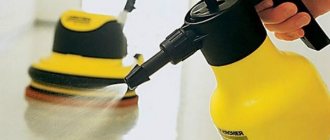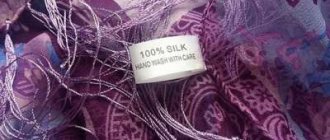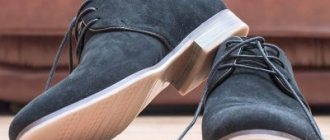If you are the owner of a glossy headset, then, most likely, you have already encountered its typical problems: small scratches, stains and fingerprints in places of “active contact”. If these “arts”, which are especially visible in the bright sun, make your heart bleed, we invite you to read our article about what problems arise when caring for a glossy kitchen, how and with what to wash it without streaks and scratches.
We bring to your attention the “messy” TOP 3 problems with varnished facades and methods for solving them.
Safe products and tools
A melamine eraser sponge works well to remove greasy deposits from furniture.
When trying to clean an MDF kitchen set, even from old deposits, you should not use abrasive or aggressive substances. They will damage the delicate surface. The following tools are prohibited for cleaning:
- hard brushes;
- metal scourers;
- sponges made of hard material;
- hard scrapers;
- rough rags.
Compliance with this rule will help prevent the appearance of scratches and roughness, which will irrevocably spoil the appearance of glossy facades.
It is better to use an old rag or soft washcloth. Positively proven in gentle cleaning:
- microfiber products;
- silicone scrapers;
- melamine sponge;
- paper towels;
- cotton swabs and disks.
Safe chemicals for washing MDF furniture
Among household chemicals, Mr Muscle is best suited for kitchen furniture
To begin with, you can try to remove dirt with products that you already have in your household: dishwashing gel or glass cleaning composition. Impregnated wet wipes or liquid and laundry soap are also suitable. If this does not help, move on to using stronger household chemicals.
To understand the assortment presented on store shelves, you need to carefully read the composition on the labels. It is strictly forbidden to use the following for cleaning MDF surfaces:
- concentrated solvents;
- alcohol-containing liquids;
- cleaning abrasive powders;
- solutions with a high content of acids and alkalis.
The most effective and safe for people are: Mr. Muscle, Cillit Bang, Shumanit, etc. All of them are tested during production, so they have minimal impact on health.
Folk remedies for removing grease in the kitchen
Baking soda, vinegar and citric acid are the most common remedies for greasy plaque.
In order to avoid allergies to chemicals, you can try to wash MDF kitchen facades using environmentally friendly methods. Traditional cleansing recipes are economical and time-tested, so it’s worth trying to use them in everyday cleaning.
The most effective formulations:
Mix mustard powder with water until a creamy slurry forms. Cover the problem area for 10-15 minutes. Then remove with a paper towel and rinse with warm water. Mustard will dissolve fat well
Use with caution on varnish and glossy surfaces.
Dilute ammonia with water in a ratio of 1 to 100. Pour the resulting solution into a spray bottle and spray all contaminated areas.
Do not rinse, wipe dry with a soft cloth. Universal cleaning liquid, ideal for almost all surfaces.
Mix vinegar and lemon juice with vodka in equal proportions, add grated zest to enhance the aroma. This option is suitable for removing medium dirt from glossy white coatings. Helps get rid of mild lime deposits from hard water. Refreshes the air in the room, also eliminating unpleasant odors.
Grate the laundry soap and dilute it with baking soda in a small amount of warm water. Place the resulting slurry on the greasy stain, gently rub with a sponge, and leave to dissolve for 20 minutes. After this, rinse thoroughly with warm water. This method has proven itself positively on matte facades.
Mix baking soda and hydrogen peroxide to the consistency of thick sour cream. Apply to the treated area and allow to dry completely. Then remove with a soft brush, then wipe with a damp cloth. Has an antibacterial effect. Fights mold.
The main reasons for contamination of MDF kitchen units
If you do not wash off the grease from MDF furniture immediately, it will eat into the surface.
During frying, even a very careful housewife will inevitably become covered with a greasy coating or splashes on the walls and cabinets around the stove. It is not always possible to scrub kitchen surfaces immediately. Dust from the air quickly sticks to them, forming dense, ingrained dirt that becomes difficult to wash off.
Unpleasant marks, especially on light-colored furniture, are also left by:
- tea leaves or coffee;
- red wine;
- beet or tomato juice;
- turmeric;
- limescale from water;
- tobacco smoke.
These stains, when quickly detected, can be easily washed off with plain water. But if you waste time, they will eat into the surface and will be difficult to remove.
You need to wash your MDF kitchen set correctly so as not to spoil the coating and restore it to its original shine and cleanliness.
Types of glossy coatings and their properties
Before cleaning the glossy surface of a kitchen unit, it is useful to know the capabilities of the material from which it is made. The choice of detergent and the method of working with it will depend on this.
When buying glossy kitchen furniture, it is important to choose the right shade of the coating. On a smooth, dark-colored surface, small stains and fingerprints are most noticeable
Light colors hide these defects.
Plastic sheets
The glossy surface of plastic sheets is the easiest to clean
All external surfaces of furniture are covered with decorative plastic of various shades. This coating has a bright color, is resistant to mechanical stress and is completely waterproof. It is easiest to clean a glossy kitchen protected with plastic gloss.
But it also has its drawbacks:
- It fades and loses color when exposed to sunlight and when treated with chemically active substances;
- Sheets can peel off from furniture boards at high temperatures and high humidity;
- Scratches and dents formed on it are almost impossible to retouch.
Painting and varnishing
Furniture boards are treated with moisture-resistant compounds of the desired color. And to give a glossy effect, several layers of varnish are applied over the paint. This coating will shine the brightest. But the technology for its creation is labor-intensive, which is why the cost of painted furniture is high.
PVC film
VVC film is the least resistant to damage
A glossy shiny surface is formed when it is glued under a vacuum press. This budget option gives good results, but is also the least maintenance-resistant.
It is necessary to wash off stains on kitchen furniture with applied film in a gentle manner and without a large amount of moisture. Under its influence, the film coating warps and peels off from the surface of the slab.
PVC does not withstand high and low temperatures well. Does not tolerate prolonged exposure to sunlight.
Acrylic coating
Sheets of this polymer material are glued to furniture boards, forming a smooth, shiny surface. The application method is no different from gluing conventional plastic. But acrylic itself has advantages. It is resistant to moisture and does not fade under sunlight.
You can wipe off dirty stains that have formed on the polymer coating using any cleaning products recommended for glossy surfaces.
Polyvinyl chloride film
She is afraid of everything - high temperatures and humidity, rough mechanical and chemical influences and abrasive additives.
Under no circumstances should PVC film be washed with a very damp cloth.
Also, the formation of cracks and peeling of the film can be caused by:
- Exposure to bright lighting fixtures;
- Temperatures below -15° C.
To prevent the film from peeling off the facade, try to wipe the surface with a not very damp cloth.
Video
The methods described above will help you quickly and effectively remove even old grease from the surfaces of kitchen furniture. To find out how everything looks in practice, we recommend watching the following videos:
Young mother, wife and part-time freelancer. Being a lawyer by training, I am accustomed to collecting and providing the most complete and reliable information. Constantly improves in the professional field and strives for personal growth and development.
Found a mistake? Select the text with the mouse and click:
Fresh lemon is not only suitable for tea: clean dirt from the surface of an acrylic bath by rubbing with half a cut citrus, or quickly wash the microwave by placing a container of water and lemon slices in it for 8-10 minutes at maximum power. The softened dirt can simply be wiped off with a sponge.
If your favorite things show the first signs of gestation in the form of untidy pellets, you can get rid of them using a special machine - a shaver. It quickly and effectively shaves off clumps of fabric fibers and returns things to their proper appearance.
Before removing various stains from clothing, you need to find out how safe the selected solvent is for the fabric itself. It is applied in a small amount to an inconspicuous area of the item from the inside out for 5-10 minutes. If the material retains its structure and color, you can move on to stains.
Threads made of gold and silver, which were used to embroider clothes in the old days, are called gimp. To obtain them, the metal wire was pulled for a long time with pliers to the required fineness. This is where the expression “to drag out the rigmarole” came from - “to do long, monotonous work” or “to delay the completion of a task.”
There are special traps to combat moths. The sticky layer with which they are covered contains female pheromones that attract males. By sticking to the trap, they are eliminated from the reproduction process, which leads to a decrease in the moth population.
Stretch ceilings made of PVC film can withstand from 70 to 120 liters of water per 1 m2 of their area (depending on the size of the ceiling, the degree of its tension and the quality of the film). So you don’t have to worry about leaks from neighbors above.
The habit of using an automatic washing machine “sparingly” can lead to the appearance of an unpleasant odor in it. Washing at temperatures below 60℃ and short rinses allow fungi and bacteria from dirty clothes to remain on internal surfaces and actively multiply.
The dishwasher cleans more than just plates and cups. You can load it with plastic toys, glass lamp shades and even dirty vegetables, such as potatoes, but only without using detergents.
The easiest way to remove scale and carbon deposits from the soleplate of the iron is with table salt. Pour a thick layer of salt onto the paper, heat the iron to maximum and run the iron over the salt bed several times, applying light pressure.
How not to wash a plastic kitchen
When buying a new kitchen, many stock up on special care products, because shining clean and shiny furniture is the pride of the owner
But before you take newfangled preparations for cleaning facades, pay attention to their composition
The larger the assortment, the more difficult it is to choose a detergent.
- Although plastic is difficult to scratch with abrasives, they nevertheless wear down the surface over time, making it less and less smooth. Therefore, cleaning such a surface becomes more and more difficult. For the same reason, you should not use hard sponges.
- Detergents containing chlorine should not be applied to plastic facades, even if drops of grease need to be removed from their surface. Such products will discolor the surface, and the facades will need to be renewed soon.
- It is not recommended to clean such facades with polishes containing wax. This is an excellent product for caring for wooden surfaces that are painted or polished, but the plastic becomes sticky after applying wax and therefore gets dirty even faster. And the layer will be much more difficult than grease stains.
- It is not advisable to apply products containing alcohol to plastic surfaces. Depending on the characteristics of the facade material, it may simply fade, especially when it comes to glossy facades. In order not to spoil the furniture with your own hands, you should first try to apply a cleaning gel or liquid to an invisible area of the facade and if the effect is negative, then stop using such products.
- Do not use detergents for plumbing fixtures, stoves or ovens to clean such a kitchen: the substances in their composition may be too aggressive for the coating. Glossy facades most often become cloudy and become covered with indelible stains as a result of using such products.
Chic, shine, beauty: do you need to polish?
To ensure that glossy facades continue to shine, polish their surfaces after cleaning .
Choose wax-free polishes. Pay attention to those that contain antistatic agents. Thanks to it you will protect the surface from the accumulation of static electricity. With such a film, dust will be less likely to settle on the headset. Cinderella polishes receive good reviews ; buyers note their high quality and low price.
Products from the brands “Pronto”, “Homestar”, “Mebelux” are popular. The selected product is applied to a pre-cleaned surface with a clean cotton or microfiber cloth. Then they wait for it to dry and carefully rub it in until the shine appears and the streaks disappear.
To polish or not is up to you to decide.
How to wash
There are quite a few ways to clean the surfaces of kitchen facades with detergents: ready-made, factory-made or homemade. Each of them is focused on a specific type of surface.
Soap solution
The simplest but effective method of cleaning a kitchen cabinet with soapy water. Finely planed laundry soap dissolved in water will help wash plastic facades.
Mustard
Mustard powder will help remove grease from kitchen utensils. It is enough to sprinkle dry mustard on the contaminated area, after moistening it with water, and then wipe it off. The cleaned surface is wiped with a dry soft cloth.
Steaming
A special device - a steam cleaner - will solve problems with drops of grease that have accumulated even in hard-to-reach places (on the top shelves, high cabinets). It works effectively not only against dirt, but also as a disinfectant.
Special means
A separate category consists of products containing chemicals, special solvents, and components to add shine. Many of them are in the house or present on the shelves of hardware stores.
Window Cleaner
Glass cleaners in convenient containers with a spray bottle will help get rid of dirty stains and restore shine to the surfaces of furniture facades. They contain special components to clean the most difficult stains and add shine. Read more here.
Spray for glossy coatings
This composition is intended for polishing and removing small scratches from the surface of varnished coatings. In combination with a gentle material, a napkin that does not scratch the surface will help restore lost shine.
Liquid soap
Modern hand washes include effective grease solvents as well as skin softening additives. A diluted soap solution for cleaning the kitchen is what is required.
Wet wipes
Wipes made of polyester and impregnated with special, mild solvents will be an excellent alternative to other products. They will not cause harm, but will help in cleaning
An important condition is that no water is used when using them.
Microfiber cloth to wipe dry
The final chord in the symphony of cleaning is a thorough wiping of the facades with a dry cloth. This is necessary to remove any remaining liquid or cleaning product from the surface of the furniture. Modern synthetic wipes are created in such a way that they are recommended even for washing cars, where one of the main conditions is the absence of an abrasive effect on the paintwork. It wouldn’t hurt to have similar ones at home for cleaning the kitchen.
Compositions with wax may leave sticky streaks and are not suitable for all materials. You can learn about the use of products in relation to a specific case from the instructions indicated on the packaging. They are definitely not suitable for plastic panels, but you can try with varnished ones.
Main
- Before deciding how to remove grease from kitchen furniture, determine the type of surface. For example, painted surfaces and wood should not be treated with abrasives or strong alkali.
- The safest traditional methods: cleaning with laundry soap and dishwashing gel - they do not leave scratches and do not spoil the color.
- Before using special chemicals, read the instructions: some products have recommended dosages.
- Wipe off grease after each cooking. It is easier to clean minor stains immediately than to scrub away old stains with professional chemicals.
How to remove brilliant green or iodine
No matter how hard you try to open a bottle of brilliant green or iodine carefully, splashes can still end up on the floor. How can I get rid of them? If the stain is not in a visible place, you can simply wait and it will fade over time with regular cleaning of the floor. But it’s better not to leave it to chance and try to eliminate contamination using available means.
Soap, washing powder
To remove a fresh stain of brilliant green, regular laundry soap or washing powder is suitable. These products are the most gentle on the linoleum surface. The soap is grated and dissolved in boiling water, the composition is cooled and applied to the stain for several hours, then washed with a rag, and after a while the procedure is repeated.
Vinegar and potassium permanganate
A mixture of table vinegar and potassium permanganate (a few crystals of potassium permanganate for half a glass of vinegar) helps well against ingrained traces of brilliant green. Leave a cloth soaked in the solution on an old stain for several minutes, then wipe with a damp sponge. If the remains of brilliant green are still visible, they are bleached with hydrogen peroxide. After removing the stain, wash the area with a damp cloth.
Ammonia or medical alcohol, nail polish remover
The products effectively remove old traces of brilliant green. They are applied to a cotton pad and treated the stain, then rinsed with water.
Starch
Starch is effective against fresh iodine stains. The contamination is moistened and covered with a damp cloth with potato starch. Instead of powdered starch, you can use potato peelings; they have a lower concentration of starch, so a longer exposure time will be required.
Soda and vinegar
The method is used to remove old iodine stains. The contaminated area is covered with powder, a little vinegar is added, and left to act overnight. In the morning, wipe with a cloth.
What not to use
There is a strict taboo on certain products in the kitchen. They must not be used under any circumstances. These are aggressive solvents, abrasives and similar compounds.
Solvents
Plastics, polymer films, paint coatings are sensitive to the action of organic solvents. In order not to permanently spoil the surfaces of the countertops or facades, before using the product, you should study its composition indicated on the label. If the word “solvent” is there, you cannot use the reagent.
Nitroglycerine
A transparent liquid slightly reminiscent of oil in consistency cannot be used for cleaning the kitchen. It cannot eliminate pollution, and there will be no particular benefit from such an alternative. And the remaining oily stains will then be difficult to remove from the glossy surface.
Alcohol
Most alcohols, including ethyl alcohols, are solvents. Alcohol-containing liquids contribute to the destruction of the integrity of paintwork coatings and loss of gloss.
Ammonia
Ammonia is also an organic solvent. Therefore, the benefit of its use for cleaning varnished surfaces and plastics is questionable.
Polymer resins
Components of adhesives and varnishes, which are polymer resins, of course, cannot be used to clean coatings. In addition, if accidentally applied to a surface, they create the following problem: how to remove this composition from the coating.
Soda and salt
Generally harmless components, however, can cause serious harm if used inappropriately. Both soda and salt are mildly abrasive materials and will certainly leave scratches on glossy facades and destroy the shine of the coating.
Shine - yes, streaks - no: how to wash a glossy kitchen set so that there are no streaks
Window and dishwashing detergents will help you clean your kitchen and avoid stains. Lather, apply to facades, then rinse thoroughly.
There are also home remedies that are simple but effective:
- Make mustard paste. Apply it to the furniture and leave for a few minutes. Then wash it off along with the stains.
- Grate a piece of laundry soap and dissolve it in a small amount of water. Wash the facades with smooth, careful movements.
- For quick cleaning, the cheapest wet wipes are suitable. Walk them over a dirty surface and you will see that they cope perfectly with fresh stains.
- Many housewives like microfiber cloths. Thanks to the properties of microfiber, they easily remove both fat films and even old drops of fat. The wipes are moistened before use - then dirt and grease are quickly absorbed between the finest fibers of the material.
Universal cleaning detergents have gained great popularity.
The list of favorites among Russian housewives includes:
- "Meine liebe." Pros: hypoallergenic, biodegradable, ECO labeled, cleans well and smells nice.
- "De la Marc". An environmentally friendly product, effective, economical, suitable for almost any surface.
- "Sanita" A concentrated product that contains many highly active substances. Provides quick action and gentle care, does not have a strong odor. Judging by the reviews, it removes fat perfectly.
- "Clean house" The product is hypoallergenic and safe for health, has no odor and cleans perfectly.
- "Bagi." The product is loved for its good price-quality ratio, gentle effect, cost-effectiveness and safety.
Before using a new product, try it on an inconspicuous area. Dilute concentrates with water.
How to clean a glossy kitchen set
Plastic for the kitchen is a budget and popular option. Its advantages, in addition to the price, include water resistance. The downside is that the plastic fades over time. Scratches and other mechanical damage easily appear on such a facade. There is no way to fix this.
If you have such a set, immediately exclude hard brushes and rags. A soft, lint-free cloth or microfiber cloth is ideal. A necessary condition is to clean the panel delicately.
Reference. How to clean a kitchen set made of glossy plastic? Gentle detergents are suitable - for example, for washing windows (without ammonia), dishes, soap solution, universal gentle cleaning products. Don't forget about wet wipes.
Dye
MDF boards are often used to make facades. These are medium-density fiberboards, which are created using the method of dry pressing of small wood chips at high pressure and temperature.
Often such slabs are painted a certain color and then covered with several layers of varnish. As a result, that same glossy effect is achieved. When cleaning painted surfaces, it is important to use products that do not have abrasive properties. You should also use only soft microfiber cloths.
You can clean a painted glossy facade, just like a plastic one, using a soap solution. You can also use glass cleaner. It will help deal with various stains on the gloss. After cleaning, you need to wipe the facade with a dry soft cloth to get rid of stains.
Care of laminated surfaces
Of all the types of plastic finishes, lamination is the least durable. Whether melamine film or PVC film is used for this, the result is the same: the coating is not resistant to mechanical damage and aggressive substances, so cleaning the kitchen set is not so easy.
The best and almost universal remedy is warm water and soap. Baby soap is used as a washing component, since it is guaranteed not to contain fragrances or “extra” additives, or dishwashing gel. The latter is effective in the fight against fat, as it includes ingredients that dissolve fat and oil. This is the easiest way to “update” your headset.
The solution is prepared literally “by eye”. The optimal composition foams slightly, but removes dirt well.
To wash the facades, use a soft sponge or a soft cloth - flannel, microfiber. For heavy dirt, you can use a special soft brush.
Pre-wetting of contaminants is not allowed - prolonged contact with water has a negative effect on the plastic. You can wash longer or increase the pressure slightly. If the grease is absorbed, then in order to wash the stain, use cleaning agents that include ammonia. This is a fairly weak alkali that can be used to wash off grease without causing damage to the plastic. Products containing alcohol and acids are excluded. To clean kitchen furniture, you can use many ready-made care products - “ABC of Cleanliness”, “Grosh” and so on. This preparation can be used with preliminary wetting. The holding time is specified in the instructions. To clean the kitchen without leaving streaks, after washing, you should clean the facades with a sponge soaked in clean water and always with a dry cloth. You also need to take care of your furniture from the inside: drawers and shelves also need to be washed with warm soapy water and wiped clean with your own hands
At the same time, pay attention not only to dirt, but also to the smell: the latter can be removed by wiping the box with a rag soaked in a vinegar solution and leaving the set open for ventilation.
How to care for MDF furniture in the kitchen
To preserve the beauty of the kitchen, proper care of MDF furniture plays an important role. It usually comes down to preventing the formation of persistent contaminants.
It will be easier to maintain cleanliness if you follow these rules:
- Keep paper towels handy and immediately clean up spills and spills.
- Use separate sponges and rags for dishes and furniture.
- Carry out general cleaning once a month so that the grease does not turn into stubborn plaque that is difficult to remove.
Regular use of these recommendations for caring for your kitchen set will help keep it in the best condition, and will also save time, money and effort on cleaning difficult stains.
How to remove grease from kitchen furniture with home remedies
Grandmother's time-tested methods will help clean your kitchen set from grease, soot and other contaminants. Their main advantages: ease of use, accessibility, environmental safety. Home remedies also do not cause allergic reactions.
Before washing your kitchen set, prepare all the necessary tools and materials:
- Ingredients for preparing detergent.
- Soft sponges and rags - flannel, microfiber, cloth.
- Thick rubber gloves to protect the delicate skin of your hands from detergents, an apron.
A mixture of baking soda and laundry soap will help remove grease from your kitchen set. This complex effect will remove stains of various natures and also disinfect surfaces.
Cleaning procedure:
- Grate the laundry soap on a coarse grater and add a small amount of water. The result should be a homogeneous solution.
- Spray all surfaces in the kitchen with the soap mixture.
- Apply a little baking soda to a sponge and thoroughly wipe cabinets, walls, shelves and countertops.
- Leave the soap and soda mixture for 15 minutes, and then wash everything with a soft sponge soaked in warm water.
Do not use soda on glossy and varnished facades. With its abrasive particles it will scratch surfaces and leave unsightly marks.
Baking soda can also be used in combination with oil. This method will help to wash cutlery, set, chairs and table.
To clean, follow these steps:
- Mix soda and vegetable oil in a 2:1 ratio to obtain a homogeneous paste.
- Apply the mixture to the stained area and scrub well with a sponge or soft brush.
- Leave the paste for 15 minutes, and after the allotted time, wipe the surfaces with a damp sponge.
It is acceptable to use soda in its pure form:
- Wipe cabinets and tables with a sponge soaked in warm water. This will soften the fat deposits and make them easier to remove.
- Mix a few tablespoons of baking soda with water to make a paste.
- Rub the resulting mixture into the surface and leave for a few minutes.
- Remove dirt with a soft sponge and then wipe all furniture thoroughly.
Alcohol-based cleaning products
Ammonia
Ammonia will help remove grease from kitchen cabinets. When working with it, follow safety rules and be sure to open the window to ventilate the pungent odor.
How to properly clean:
- Dissolve 1 tbsp in 1 liter of water. l. ammonia.
- Use the resulting solution to treat all greasy surfaces using a sponge or spray bottle.
- After a couple of minutes, wipe the facades with a clean damp cloth.
Vinegar and alcohol
A mixture of vinegar and alcohol will help deal with grease on cabinets. This product not only effectively removes dirt from any surfaces, but also disinfects them.
Cleaning procedure:
- Mix water, vinegar and alcohol in a 2:1:1 ratio.
- Add a few drops of any essential oil to the resulting mixture.
- Using a spray bottle, apply the solution to contaminated surfaces and leave for 15 minutes.
- After the allotted time, wash off any remaining product with a damp washcloth.
Vinegar is an acid, it has a corrosive effect and causes flowers to fade. Do not use the product on colored or painted surfaces or delicate materials.
Other ways to clean kitchen cabinet fronts
Mustard powder
Mustard powder will help clean furniture and kitchen appliances from grease deposits:
- Wipe contaminated areas with a soft, damp cloth.
- Sprinkle mustard powder generously over the oily areas and leave for a couple of minutes.
- Wipe the surfaces with a clean napkin, removing mustard, grease, soot and soot.
Using mustard powder you can clean the refrigerator, electric stove, and cabinet fronts. However, this method is not suitable for wooden surfaces.
Salt
A solution of table salt will help to cope with stains on plastic surfaces:
- Dissolve 1 tbsp in 1 liter of warm water. l. salt.
- Soak a soft cloth in the resulting product and treat all surfaces with it, thoroughly wiping off old dirt.
- If necessary, repeat the treatment several times.
Glossy furniture in the kitchen interior – 50 photo ideas:
PreviousKitchenPorcelain stoneware countertops are the queen of the kitchen!
Next
KitchenHow to make a kitchen countertop with your own hands
Methods of cleaning with household chemicals
If the contamination is complex, for example, frozen splashes from vegetable oil or fat, traces of sauce, then ordinary water and a rag will not help. You need to use stronger detergents to clean furniture. It can be:
- Dishwashing detergents. They perfectly break down fats and help eliminate pollution. It is enough to apply a few drops of cleaning liquid to a soft sponge and rub it over the entire surface of the headset. You need to leave the product for a couple of minutes to develop its properties, and then rinse with a damp viscose cloth and wipe dry. The detergent does not leave streaks and is easily washed off the façade.
- Glass cleaning liquid. It contains active components that cope with pollution of any nature. The liquid does not leave streaks on the plastic and is removed along with dissolved dirt or greasy stains. It is convenient to use. Spray a little liquid onto the kitchen façade from a spray bottle and wipe it with a dry, clean cloth.
- Universal cleaners. To clean plastic kitchen panels, you can use detergents in the form of gels or liquids. They have a more pronounced chemical effect than glass or dishwashing liquids. The detergent can remove strong or old stains. It is applied with a foam sponge to the area of contamination and left for 3-5 minutes, then washed off with warm water.
- Aggressive detergents or auto chemicals. This last category of plastic cleaners. These products contain caustic substances - alkalis, derivatives of bases. The products are highly effective in cleaning, but can damage the surface if they interact for a long time. Before use, the liquid is tested on an inconspicuous area. If everything went well, then spread the product in a uniform layer over the contaminated plastic and rub with a soft sponge until stains and greasy marks are eliminated.
Acrylic plastic
It tolerates wet cleaning well and can be treated with polish. It does not fade in the sun, does not fade and is resistant to mechanical stress.
Contaminants from such a surface can be removed quite easily. These facades can be polished when defects appear on them.
However, it is also sensitive to the chemical composition of cleaning products.
Under no circumstances should you wash them with aggressive detergents, as you may lose the shine of the glossy façade.
Rules for caring for plastic kitchens
A plastic kitchen is a practical, inexpensive, and also convenient option. Modern technology has now reached its limit, and plastic kitchens are now of the highest quality. Plastic is now resistant to high temperatures; neither moisture nor steam will harm it.
Caring for a plastic kitchen won’t be particularly difficult, but it’s better to do it regularly, avoiding too much contamination. You can wash the plastic with a damp cloth, soapy water or a gentle cleaner. Afterwards, wipe dry with a towel or rag. It is better not to use brushes with hard teeth, as they can scratch the surface of the kitchen, and restoration will be very difficult.
A plastic kitchen should be constantly dry, because constant contact with water has a very bad effect on plastic.
It is also better not to wipe with alcohol, after which the plastic surface will become dull and appear dusty.
What products should not be used to clean a plastic kitchen?
There are a lot of different products for cleaning plastic surfaces on store shelves. But sometimes it is worth making sure that such substances do not contain certain impurities:
- Solvents
- Acetone
- Chlorine
- Acid containing ingredients
These ingredients can corrode the plastic surface of your kitchen, so be careful.
How to care for a wooden kitchen
A wooden kitchen is not as rare as a glossy or plastic one. Many housewives have already gotten used to it and know all the secrets of caring for such a set. They know all the pros and cons of this furniture.
Three tips for caring for wooden kitchen furniture:
Painted MDF with varnish
A high-quality multi-layer varnish coating applied over enamel paint does not peel off, does not allow moisture to pass through, and does not fade from bright daylight.
Small defects during use on a painted surface can be corrected, unlike plastic.
The scratched surface can be easily restored. Does not tolerate melamine sponge and high temperatures.
But you still need to try as much as possible to avoid scratches.
Features for caring for various surfaces
Laminated chipboard
Modern laminated chipboard is of high quality, so caring for it is quite simple. General rules are sufficient: wipe with a damp cloth and a non-abrasive cleaner, keep dry. You can use a variety of polishes, widely available in stores.
Important! You should use special polishes for plastics - you should not use polishes that have contraindications for contact with food products
Plastic facades
Plastic facades with aluminum trim – easy and quick to clean
How to clean a plastic kitchen? You can use all types of cleaning products that do not contain chlorine or abrasives. The care of plastic facades itself is very simple - plastic does not absorb any substances, so the set does not become dirty for a long time, maintaining an aesthetic appearance.
Plastic surfaces, in comparison with other materials used in manufacturing, are the most durable and scratch-resistant. However, choosing hard brushes, scrapers, and other tools with metal or plastic fibrous materials for cleaning is unacceptable.
Advice! You can also take special polishes for plastics for cleaning (their prices in stores are quite reasonable).
MDF facades
Photo: MDF should be washed avoiding mechanical stress.
How to clean an MDF kitchen? In terms of strength and resistance to moisture, this material is superior to natural wood. And it’s easy to care for MDF furniture – you just need to wipe it with soap-based cleaning products. Also use all kinds of polishes.
Important! When cleaning MDF furniture, do not use chlorine-containing products. During operation, try to avoid mechanical impacts on MDF to avoid damage to the facades
It is also unacceptable to use hard brushes and scrapers with metal or plastic fibrous materials for cleaning - they scratch the base
During operation, try to avoid mechanical impacts on MDF to avoid damage to the facades. It is also unacceptable to use hard brushes and scrapers with metal or plastic fibrous materials for cleaning - they scratch the base.
Glossy surfaces - features of their care
How to clean a glossy kitchen? This question is the most basic one asked on forums on the Internet. A significant disadvantage of gloss is that dirt on this surface is always more noticeable than on a matte surface. But glossy finishes are much easier to clean than matte facades. The main thing here is regular cleaning.
The most effective method to clean glossy surfaces depends on what the glossy finish is made of:
- special varnish or paint;
- acrylic or PVC film.
Before you start cleaning, you can experiment with different products.
Important! Do not use abrasive products for cleaning; scratches can easily appear on the gloss. How to clean a glossy kitchen? Housewives use:
How to clean a glossy kitchen? Housewives use:
- dishwashing liquids;
- shower gels;
- soap;
- shampoos;
- specialized cleaning liquids;
- special products for glass;
- polish and so on.
Attention! Some gels for plumbing fixtures and glass may contain aggressive substances, which can cause the gloss to become cloudy and dull, or become streaky. And nothing can wash them away
How to clean grease in the kitchen? The most universal method is to use soft degreasing gels.
- It is best to wipe the bases with a microfiber cloth.
- After cleaning, wipe the base with a dry cloth.
- And your kitchen furniture will sparkle with its mirror shine.
- You will only need to regularly maintain this beauty, eliminating the smallest impurities.
Golden rules of care
Juicy cutlets are not only a delicious dinner, but also splashes of hot oil. An airy cake – childish joy and droplets of cream on the facade. Even if you are extremely careful, almost every culinary masterpiece you create will leave its autograph on the headset.
Gloss is a “champion” for collecting droplets of grease, fingerprints and various stains . Therefore, ideally it should be cleaned after each cooking or at least daily.
Here are a few rules that will help you care for glossy furniture :
- The first principle of care is regularity. Try to take care of it more often and prevent grease and stains from drying out. This is much easier than later using heroic efforts to return it to its former purity.
- If you want to enjoy the beauty of your kitchen for a long time, wring out the cloth well when cleaning, and after cleaning, wipe the surfaces dry. Protecting your kitchen from excessive humidity will extend its service life. Moisture causes mold to form and causes furniture to swell. If the set is covered with PVC film, it will easily peel off. Make sure that the hood is working in the room.
- Ultraviolet rays damage facades and they lose their shine. Protect the set from direct sunlight with thick curtains or blinds.
- When cleaning, do not use any rough cloths and forget about dish sponges. How to clean the glossy surface of a kitchen set? Arm yourself with a flannel, a soft, lint-free cloth, or even better, a microfiber cloth. Microfiber cloths capture and hold dust particles. This prevents scratches.
- Use only gentle products. Abrasives are not suitable for glossy facades. Forget about powders and products that contain alcohol, acetone, ammonia, chlorine, and wax. Chlorine and alcohol discolor the paint, and wax makes the surface sticky and collects even more dust.
It can be useful:
How to clean the space inside the refrigerator
How to clean the inside of a microwave oven from grease stains
Products for washing and cleaning glass hobs
So that the furniture shines with cleanliness, and you with delight
To carefully and effectively clean your kitchen unit from grease and dirt, use regular laundry soap. Grate it on a fine grater and dilute it in warm water until a soap solution forms.
Laundry soap diluted in water will help to wash the plastic surface without unnecessary damage.
Clean in three steps:
- Start by applying the solution to it;
- Then wipe first with a wrung out damp cloth and then with a dry cloth;
- Be sure to ventilate the room.
Soap solution is the most harmless for glossy finishes of kitchen units, but does not always give a good result.
To effectively clean facades, many housewives quite successfully use:
- Glass cleaners (without ammonia);
- With special sprays for a glossy finish;
- Detergents for shower cabins;
- Shampoos and liquid soap;
- Dishwashing detergents;
- Wax-free polishes;
- Hydrogen peroxide.
To wash surfaces with a glossy facade, use non-abrasive detergents.
If you find a fresh greasy stain or dirty streaks on the facade, then try to wipe them off with light pressure with a flannel rag moistened with glass cleaner.
For painted glossy facades it is good to use glass cleaner.
IMPORTANT! Carry out such cleaning as often as possible - and you won’t have to make heroic efforts to remove old defects
It is recommended to apply the product to the facades and wipe with a dry microfiber cloth.
The glossy facade will retain its radiant shine for a long time if you handle it with care.
Select cleaning products carefully and use wipes made of soft and non-woven materials.
Common types of pollution
Kitchen surfaces must be cleaned from various types of contaminants, including:
- Grease and other food stains.
- Fingerprints: Particularly visible on dark surfaces.
- Dust: accumulates on furniture of any shade, but is more noticeable on furniture of dark colors.
- Stains (most often appear as a result of improper washing), as well as traces of dried drops of water (especially visible if the water is hard).
- Scratches on facades: although they are not directly related to dirt, they are also a common problem faced by owners of kitchen units. These are not only external defects, dirt can become clogged and accumulated in them.
To get rid of some types of dirt, it is enough to regularly wipe the headset with a cloth. It will be more difficult to wash glossy facades from dried dirt, remove stubborn stains, wash off grease or restore a scratched surface. Below we will consider how and what is recommended to wash furniture in order to avoid the most complex, difficult-to-remove stains, as well as reduce the risk of mechanical damage and discoloration of furniture materials.
Cleaning Methods
- Use of liquid products. First, a cleaning composition is applied to the glossy façade. Some products are sold in the form of sprays, which are very convenient to use. If you don't have a sprayer, use the soft side of the sponge. After leaving the composition for some time to corrode the dirt, wipe the glossy surface with a dry cloth.
- Reviews emphasize the ease of use of wet wipes. These are ready-made kitchen cleaning products impregnated with a special composition. There is no need to purchase additional detergents. Simply take the wipes out of the package and wipe the glossy surfaces.
- Steam exposure. Quite an interesting way to clean glossy surfaces. You need to warm up the steamer and then carefully move it over the stains without touching the surface of the furniture. By softening the contaminants, you can stop the steam exposure. All that remains is to use a clean napkin to completely clean the surface.
Problem No. 3. Scratches appeared
If the scratch is small, try the good old remedy - sunflower oil. Try soaking a cotton pad in it and wiping the surfaces.
If the chip is of “moderate severity” but does not reach the wood, you can use:
- Wax polish. Rub it thoroughly over the damaged area until it becomes smooth.
- Special spray varnish for door repair (halo-free, based on one-component acrylic). It can be purchased from door manufacturers or sellers - you are unlikely to find it in a regular repair store. The rules for its use are described on the label of the can.
In case of serious damage to varnished veneer, there is also a good solution:
- Pick up a hard wax pencil that matches the color of your facades at a hardware store (in the door or laminate department).
- Melt the pencil (or simply knead the wax with your fingers) and rub the dent until the wax completely fills it.
- Wait until the wax hardens, and then carefully remove any excess wax with a spatula or blade (not a rag!).
- Sand the area using a sander or 400-grit sandpaper.
- Cover the surface with a non-halo repair varnish (the usual one will not work, it will crumble quickly).
These instructions are also suitable for film facades. The most difficult thing is to choose the right color. If the film imitates wood, then you can use a set of markers for laminate flooring. In this case, there is a 100% chance of hitting the color.
Tip: before going to the “heavy artillery” and rubbing the varnish with various polishes and waxes, try to carefully cover the chip using a thin artist’s brush and matte varnish. Perhaps the result at this stage will satisfy you.
If the scratch is so deep that the wood is touched, then before applying wax we clean the edge, mix the stain with alcohol or solvent and tint the damaged area. Then do steps 1–4 above.
If the facades of your set are made of glossy plastic, then it is almost impossible to correct its flaws. Most likely, the plastic will have to be re-glued.











